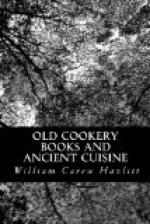To make it Elder Ale:—Take ten bushels of malt to a hogshead, then put two bushels of elder-berries pickt from the stalks into a pot or earthen pan, and set it in a pot of boiling water till the berries swell, then strain it out and put the juice into the guile-fat, and beat it often in, and so order it as the common way of brewing.
To clear Wine:—Take half a pound of hartshorn, and dissolve it in cyder, if it be for cyder, or Rhenish-wine for any liquor: this is enough for a hogshead.
To fine Wine the Lisbon way:—To every twenty gallons of wine take the whites of ten eggs, and a small handful of salt, beat it together to a froth, and mix it well with a quart or more of the wine, then pour it in the vessel, and in a few days it will be fine.
COOKERY BOOKS.
PART III.
In 1747 appeared a thin folio volume, of which I will transcribe the title: “The Art of Cookery, Made Plain and Easy, which far Exceeds Every Thing of the Kind Ever yet Published ... By a Lady. London: Printed for the Author; and sold at Mrs. Ashburn’s, a China Shop, the Corner of Fleet Ditch. MDCCXLVII.” The lady was no other than Mrs. Glasse, wife of an attorney residing in Carey Street; and a very sensible lady she was, and a very sensible and interesting book hers is, with a preface showing that her aim was to put matters as plainly as she could, her intention being to instruct the lower sort. “For example,” says she, “when I bid them lard a fowl, if I should bid them lard with large lardoons they would not know what I meant; but when I say they must lard with little pieces of Bacon, they know what I mean.” I have been greatly charmed with Hannah Glasse’s “Art of Cookery,” 1747, and with her “Complete Confectioner” likewise in a modified degree. The latter was partly derived, she tells you, from the manuscript of “a very old experienced housekeeper to a family of the first distinction.” But, nevertheless, both are very admirable performances; and yet the compiler survives scarcely more than in an anecdote for which I can see no authority. For she does not say, “First catch your hare” [Footnote: Mrs. Glasse’s cookery book was reprinted at least as late as 1824].
Mrs. Glasse represents that, before she undertook the preparation of the volume on confectionery, there was nothing of the kind for reference and consultation. But we had already a curious work by E. Kidder, who was, according to his title-page, a teacher of the art which he expounded eventually in print. The title is sufficiently descriptive: “E. Kidder’s Receipts of Pastry and Cookery, for the use of his Scholars, who teaches at his School in Queen Street, near St. Thomas Apostle’s, [Footnote: In another edition his school is in St. Martin’s Le Grand] on Mondays, Tuesdays and Wednesdays, in the afternoon. Also on Thursdays, Fridays and Saturdays, in the afternoon, at his School next to Furnivalls Inn in Holborn. Ladies may be taught at their own Houses.” It is a large octavo, consisting of fifty pages of engraved text, and is embellished with a likeness of Mr. Kidder. For all that Mrs. Glasse ignores him.




